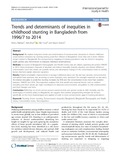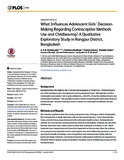Browsing Journal Articles (2016) by Title
Now showing items 6-10 of 10
-
The global burden of women's cancers: a grand challenge in global health
(© 2017 The Lancet, 2017-02-25)Every year, more than 2 million women worldwide are diagnosed with breast or cervical cancer, yet where a woman lives, her socioeconomic status, and agency largely determines whether she will develop one of these cancers ... -
Health impact of climate change in Bangladesh: a summary
(© 2016 Current Urban Studies, 2016)Bangladesh, one of the South Asian countries, has started experiencing major public health impacts of climate change due to its vulnerable geographical location. The objective of this paper is to look at the extent of ... -
Role of spatial tools in public health policymaking of Bangladesh: opportunities and challenges
(© 2016 Journal of Health, Population and Nutrition, 2016-02)In spite of the increasing efforts to gather spatial data in developing countries, the use of maps is mostly for visualization of health indicators rather than informed decision-making. Various spatial tools can aid ... -
Trends and determinants of inequities in childhood stunting in Bangladesh from 1996/7 to 2014
(© 2016 International Journal for Equity in Health, 2016-11-16)Background We explore long-term trends and determinants of socioeconomic inequities in chronic childhood undernutrition measured by stunting among under-five children in Bangladesh. Given that one in three children remain ... -
What influences adolescent girls’ decision-making regarding contraceptive methods use and childbearing? a qualitative exploratory study in Rangpur district, Bangladesh
(© 2016 Plos One, 2016-06-23)Background: Bangladesh has the highest rate of adolescent pregnancy in South Asia. Child marriage is one of the leading causes of pregnancies among adolescent girls. Although the country's contraceptive prevalence rate is ...


